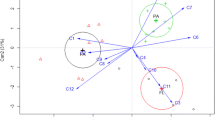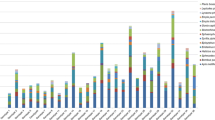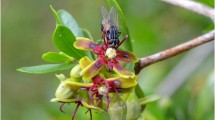Abstract
Chemical signals emitted by the plant frequently mediate host-plant localization in specialized animal – plant associations. Studying the interdependent highly specialized association of the narrowly oligolectic bee pollinator Protodiscelis palpalis (Colletidae, Neopasiphaeinae) with Hydrocleys martii (Alismataceae) in ephemeral aquatic water bodies in semi-arid Caatinga of Brazil, we asked if specific volatile compounds produced by the flowers mediate pollinator attraction. The yellow Hydrocleys flowers are the sole pollen and nectar resources, and mating sites for the bees. We analyzed the floral scents of this species and of the closely related H. nymphoides, which is not visited by P. palpalis, and tested the main volatile compounds of both species under field conditions to evaluate their attractiveness to bees of P. palpalis. Methoxylated aromatics were the dominant floral scent components in both species, but each species exhibited a characteristic scent profile. Dual choice bioassays using artificial flowers made of yellow and blue adhesive paper clearly revealed that ρ-methylanisole alone, the dominant volatile of H. martii, attracted significantly more bees than unbaited flowers. This compound represents an olfactory communication channel used by the plant that lures its effective oligolectic pollinators to its flowers. Yellow artificial flowers baited significantly more bees than blue ones. Our study reinforces the recent findings that specific compounds in complex floral scent bouquets are crucial for host-plant location in oligolectic bees.


Similar content being viewed by others
References
Adams RP (2007) Identification of essential oil components by gas chromatography/mass spectrometry. Allured Publishing Corporation, Carol Stream, Illinois
Almeida EAB, Danforth BN (2009) Phylogeny of colletid bees (Hymenoptera: Colletidae) inferred from four nuclear genes. Mol Phyl Evol 50:290–309. doi:10.1016/j.ympev.2008.09.028
Almeida EAB, Pie MR, Brady SG, Danforth BN (2012) Biogeography and diversification of colletid bees (Hymenoptera: Colletidae): emerging patterns from the southern end of the world. J Biogeogra 39:526–544. doi:10.1111/j.1365-2699.2011.02624.x
Andrade-Lima D (1981) The caatingas dominium. Rev Bras Bot 4:149–163
Andrews ES, Theis N, Adler LS (2007) Pollinator and herbivore attraction to Cucurbita floral volatiles. J Chem Ecol 33:1682–1691. doi:10.1007/s10886-007-9337-7
APGIII (The Angiosperm Phylogeny Group) (2009) An update of the angiosperm phylogenetic group classification for the orders and families of flowering plants: APG III. Bot J Linn Soc 161:105–121. doi:10.1111/j.1095-8339.2009.00996.x
Ayasse M, Stökl J, Francke W (2011) Chemical ecology and pollinator-driven speciation in sexually deceptive orchids. Phytochemistry 72:1667–1677. doi:10.1016/j.phytochem.2011.03.023
Braun M, Dötterl S, Gottsberger G (2011) Absence of pollinators and apomictic fruit production in an Atlantic rainforest population of Cymbopetalum brasiliense (annonaceae). Plant Syst Evol 296:265–273. doi:10.1007/s00606-011-0493-4
Burger H, Dötterl AM (2010) Host-plant finding and recognition by visual and olfactory floral cues in an oligolectic bee. Funct Ecol 24:1234–1240. doi:10.1111/j.1365-2435.2010.01744.x
Burger H, Ayasse M, Häberlein CM, Schulz S, Dötterl S (2010) Echium and Pontechium specific floral cues for host-plant recognition by the oligolectic bee Hoplitis adunca. S Afr J Bot 76:788–795. doi:10.1016/j.sajb.2010.08.003
Burger H, Dötterl S, Häberlein CM, Schulz S, Ayasse M (2012) An arthropod deterrent attracts specialised bees to their host plants. Oecologia 168:727–736. doi:10.1007/s00442-011-2136-4
Burger H, Ayasse M, Dötterl S, Kreissl S, Galizia CG (2013) Perception of floral volatiles involved in host-plant finding behaviour: comparison of a bee specialist and generalist. J Comp Physiol A 199:751–761. doi:10.1007/s00359-013-0835-5
Cane JH, Sipes S (2006) Characterizing floral specialization by bees: analytical methods e-revised lexicon for oligolecty. In: Waser NM, Ollerton J (eds) Plan-pollination interactions: from specialization to generalization. The University of Chicago Press, Chicago, pp 99–121
Carvalho AT (2012) Interações entre Protodiscelis (Colletidae, Neopasiphaeinae) e plantas aquáticas e a importância de odores florais na atração de polinizadores. PhD thesis, Universidade Federal da Paraíba, João Pessoa, Brasil
Carvalho AT, Schlindwein C (2011) Obligate association of an oligolectic bee and a seasonal aquatic herb in semi-arid north-eastern Brazil. Biol J Linn Soc 102:355–368. doi:10.1111/j.1095-8312.2010.01587.x
Carvalho AT, Maia ACD, Ojima PY, Santos AA, Schlindwein C (2012) Nocturnal bees are attracted by widespread floral scents. J Chem Ecol 38:315–318. doi:10.1007/s10886-012-0084-z
Chen C, Song QS, Proffit M, Bessiere JM, Li ZB, Hossaert-McKey M (2009) Private channel: a single unusual compound assures specific pollinator attraction in Ficus semicordata. Funct Ecol 23:941–950. doi:10.1111/j.1365-2435.2009.01622.x
Clarke KR, Gorley RN (2006) Primer v6: User Manual/Tutorial. Primer-E: Plymouth.1-91.
Dobson HEM (1987) Role of flower and pollen aromas in host plant recognition by solitary bees. Oecologia 72:618–623. doi:10.1007/BF00378991
Dobson HEM (2006) Relationship between floral fragrance composition and type of pollinator. In: Dudareva N, Pichersky E (eds) Biology of floral scent. CRC Press/Taylor and Francis Group, Boca Raton, pp 147–198
Dobson HEM, Bergström G (2000) The ecology and evolution of pollen odors. Plant Syst Evol 222:63–87. doi:10.1007/BF00984096
Dötterl S, Jürgens A (2005) Spatial fragrance patterns in flowers of Silene latifolia: lilac compounds as olfactory nectar guides? Plant Syst Evol 255:99–109. doi:10.1007/s00606-005-0344-2
Dötterl S, Vereecken NJ (2010) The chemical ecology and evolution of bee–flower interactions: a review and perspectives. Can J Zool 88:668–697. doi:10.1139/Z10-031
Dötterl S, Füssel U, Jürgens A, Aas G (2005) 1,4 dimethoxybenzene, a floral scent compound in willows that attracts an oligolectic bee. J Chem Ecol 31:2993–2998. doi:10.1007/s10886-005-9152-y
Dötterl S, Milchreit K, Schäffler I (2011) Behavioural plasticity and sex differences in host finding of a specialized bee species. J Comp Physiol A 197:1119–1126. doi:10.1007/s00359-011-0673-2
Dötterl S, David A, Boland W, Silberbauer-Gottsberger I, Gottsberger G (2012) Evidence for behavioral attractiveness of methoxylated aromatics in a dynastid scarab beetle-pollinated araceae. J Chem Ecol 38:1539–1543. doi:10.1007/s10886-012-0210-y
Dressler RL (1982) Biology of the orchid bees (Euglossini). Annu Rev Ecol Syst 13:373–394. doi:10.1146/annurev.es.13.110182.002105
El-Sayed AM (2011) The pherobase: Database of pheromones and semiochemicals. Available at <http://www.pherobase.com>
Ervik F, Tollsten L, Knudsen JT (1999) Floral scent chemistry and pollination ecology in phytelephantoid palms (Arecaceae). Plant Syst Evol 217:279–297. doi:10.1007/BF00984371
Haynes RR, Holm-Nielsen LB (1992) The limnocharitaceae. Flora Neotrop Mono New York Bot Garden 56:1–32
Knudsen JT, Eriksson R, Gershenzon J, Ståhl B (2006) Diversity and distribution of floral scent. Bot Rev 72:1–120. doi:10.1663/0006-8101(2006)72[1:DADOFS]2.0.CO;2
Maia ACD, Dötterl S, Kaiser R, Silberbauer-Gottsberger I, Teichert H, Gibernau M, Navarro DMAF, Schlindwein C, Gottsberger G (2012) The key role of 4-methyl-5-vinylthiazole in the attraction of scarab beetle pollinators: a unique olfactory floral signal shared by annonaceae and araceae. J Chem Ecol 38:1072–1080. doi:10.1007/s10886-012-0173-z
Maia ACD, Gibernau M, Dötterl S, Navarro DMAF, Seifert K, Müller T, Schlindwein C (2013) The floral scent of Taccarum ulei (Araceae): attraction of scarab beetle pollinators to an unusual aliphatic acyloin. Phytochemistry 93:71–78. doi:10.1016/j.phytochem.2013.03.005
McDonald JH (2009) Handbook of biological statistics (2nd ed.). Sparky House Publishing, Baltimore, Maryland. as pp. 46–51. Availiable Http://udel.edu/~mcdonald/statgtestgof.html
Michener CD (2007) The bees of the world. The Johns Hopkins University Press, London
Milet-Pinheiro P, Ayasse M, Schlindwein C, Dobson HEM, Dötterl S (2012) Host location by visual and olfactor y floral cues in an oligolectic bee: innate and learned behavior. Behav Ecol 23:531–538. doi:10.1093/beheco/arr219
Milet-Pinheiro P, Ayasse M, Dobson HEM, Schlindwein C, Francke W, Dötterl S (2013) The chemical basis of host-plant recognition in a specialized bee pollinator. J Chem Ecol 39:1347–1360. doi:10.1007/s10886-013-0363-3
Minckley RL, Roulston TH (2006) Incidental mutualisms and pollen specialization among bees. In: Waser NM, Ollerton J (eds) Plant-pollinator interactions: from specialization to generalization. The University of Chicago Press, Chicago, pp 69–98
Oliveira R, Carvalho AT, Schlindwein C (2012) Territorial or wandering: how males of Protodiscelis palpalis (Colletidae, Paracolletinae) behave in searching for mates. Apidologie 43:674–684. doi:10.1007/s13592-012-0142-0
Oliveira R, Carvalho AT, Schlindwein C (2013) Plasticity in male territoriality of a solitary bee under different environmental conditions. J Insect Behav 26:690–694. doi:10.1007/s10905-013-9385-5
Ollerton J, Winfrre R, Tarrant S (2011) How many flowering plants are pollinated by animals? Oikos 120:321–326. doi:10.1111/j.1600-0706.2010.18644.x
Prado D (2003) As caatingas da América do Sul. In: Leal IR, Tabarelli M, Silva JMC (eds) Ecologia e conservação da Caatinga. Editora Universitária: Universidade Federal de Pernambuco, Recife, Brasil pp, 3–73
Raguso RA (2003) Olfactory landscapes and deceptive pollination: signal, noise and convergent evolution in floral scent. In: Blomquist GJ, Vogt RG (eds) Insect pheromone biochemistry and molecular biology. The biosynthesis and detection of pheromones and plant volatiles. Elsevier Academic Press, Amsterdam, pp 631–650
Raguso RA (2008) Wake up and smell the roses: the ecology and evolution of floral scent. Annu Rev Ecol Syst 39:549–569. doi:10.1146/annurev.ecolsys.38.091206.095601
Robertson C (1925) Heterotropic bees. Ecology 6:412–436. doi:10.2307/1929107
Roubik DW, Hanson PE (2004) Orchid bees of tropical America: biology and field guide. InBIO Press (Editorial INBio) Spanish/English edition, Heredia
Saini RK, Hassanali A (2007) 4-Alkyl-substituted analogue of guaiacol shows greater repellency to Savannah tsetse (Glossina spp.). J Chem Ecol 33:985–99. doi:10.1007/s10886-007-9272-7
Schiestl FP, Marion-Poll F (2002) Detection of physiologically active flower volatiles using gas chromatography coupled with electroantennography. In: Jackson JF, Linskens HF, Inman R (eds) Molecular methods of plant analysis volume 21 analysis of taste and aroma. Springer, Berlin, pp 173–198
Schiestl FP, Ayasse M, Paulus HF, Löfstedt C, Hansson BS, Ibarra F, Francke W (1999) Orchid pollination by sexual swindle. Nature 399:421–422. doi:10.1038/20829
Schiestl FP, Peakall R, Mant JG, Ibarra F, Schulz C, Franke S, Francke W (2003) The chemistry of sexual deception in an orchid-wasp pollination system. Science 302:437–438. doi:10.1126/science.1087835
Schiestl FP, Huber FK, Gomez JM (2011) Phenotypic selection on floral scent: trade-off between attraction and deterrence? Evol Ecol 25:237–248. doi:10.1007/s10682-010-9409-y
Schlindwein C (1998) Frequent oligolecty characterizing a diverse bee-plant community in a xerophytic bushland of subtropical Brazil. Stud Neotrop Fauna E 33:46–59. doi:10.1076/snfe.33.1.46.2168
Schlindwein C (2004) Are oligolectic bees always the most effective pollinators? In: Freitas BM, Pereira JOP (eds) Solitary bees. Conservation, rearing and management for pollination. Imprensa Universitária, Fortaleza, pp 231–240
Schlindwein C, Wittmann D (1997) Micro-foraging routes of Bicolletes pampeana (Colletidae) and bee-induced pollen presentation in Cajophora arechavaletae (Loasaceae). Bot Acta 110:177–183
Silveira FAA (2009) Synopsis of Actenosigynes Moure, Graf & Urban, 1999 (Hymenoptera: Colletidae) – new species, possible oligolecty and biogeographic comments. Zootaxa 2292: 15–24. ISSN 1175–5334
Stensmyr MC, Urru I, Collu I, Celander M, Hansson BS, Angioy A (2002) Rotting smell of dead-horse arum florets. Nature 420:625–626. doi:10.1038/420625a
Acknowledgments
We thank Irmgard Schäffler and Paulo Milet-Pinheiro for help in the laboratory, Antonio de Brito Tenório and Leniro Tenorio Vaz for support during fieldwork, and ICMBio for collection license 12737–1. The study received financial support by the Brazilian Research Council (CNPq Universal 481605/2011-8); ATC and CS acknowledge research grants from CNPq and CAPES (Coordenação de Aperfeiçoamento de Pessoal de Nível Superior), Brazil.
Author information
Authors and Affiliations
Corresponding author
Rights and permissions
About this article
Cite this article
Carvalho, A.T., Dötterl, S. & Schlindwein, C. An Aromatic Volatile Attracts Oligolectic bee Pollinators in an Interdependent bee-Plant Relationship. J Chem Ecol 40, 1126–1134 (2014). https://doi.org/10.1007/s10886-014-0510-5
Received:
Revised:
Accepted:
Published:
Issue Date:
DOI: https://doi.org/10.1007/s10886-014-0510-5




